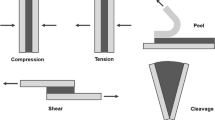Abstract
The curing kinetics of a bi-component system about o-cresol-formaldehyde epoxy resin (o-CFER) modified by liquid crystalline p-phenylene di[4-(2,3-epoxypropyl) benzoate] (p-PEPB), with 3-methyl-tetrahydrophthalic anhydride (MeTHPA) as a curing agent, were studied by non-isothermal differential scanning calorimetry (DSC) method. The relationship between apparent activation energy E a and the conversion α was obtained by the isoconversional method of Ozawa. The reaction molecular mechanism was proposed. The results show that the values of E a in the initial stage are higher than other time, and E a tend to decrease slightly with the reaction processing. There is a phase separation in the cure process with LC phase formation. These curing reactions can be described by the Šesták–Berggren (S–B) equation, the kinetic equation of cure reaction as follows: \( {\frac{{{\text{d}}\alpha }}{{{\text{d}}t}}} = A\exp \left( { - {\frac{{E_{\text{a}} }}{RT}}} \right)\alpha^{m} \left( {1 - a} \right)^{n} \).










Similar content being viewed by others
References
Akira I, Takeaki S, Yoshiji M, Haruhiko F, Hiroshi U. Hardening organic resin composition. Jpn Kokai Tokkyo Koho 2002;2002080727.
López J, Rico M, Montero B, Díez J, Ramírez C. Polymer blends based on an epoxy-amine thermoset and a thermoplastic: Effect of thermoplastic on cure reaction and thermal stability of the system. J Therm Anal Calorim. 2009;95:369–76.
Ramírez C, Rico M, Barral L, Díez J, García-Garabal S, Montero B. Organic/inorganic hybrid materials from an epoxy resin cured by an amine silsesquioxane. J Therm Anal Calorim. 2007;87:69–72.
Sharma P, Choudhary V, Narula AK. Curing kinetics and thermal stability of diglycidyl ether of bisphenol: Mixture of aromatic imide-amines of benzophenone 3,3′,4,4′-tetra-carboxylic acid dianhydride and 4,4′-diaminodiphenylsulfone. J Therm Anal Calorim. 2008;91:231–6.
Villanueva M, Martín-Iglesias JL, Rodríguez-Añón JA, Proupín-Castiñeiras J. Thermal study of an epoxy system DGEBA (n = 0)/mXDA modified with POSS. J Therm Anal Calorim. 2009;96:575–82.
Jahromi S, Kuipers WAG, Norder B, Mijs WJ. Liquid crystalline epoxide thermosets: dynamic mechanical and thermal properties. Macromolecules. 1995;28:2201–11.
Hoyle CE, Watanab T, Whitehead J. Anisotropic network formation by photopolymerization of liquid crystal monomers in a low magnetic field. Macromolecules. 1994;27:6581–8.
Kurihara S, Iwamoto K, Nonaka T. Preparation and structure of polymer networks by polymerization of liquid crystalline monomers in DC electric field. Polymer. 1998;39:3565–9.
Zhao H, Gao JG, Li YF, Shen SG. Curing kinetics and thermal property characterization of bisphenol-F epoxy resin and MeTHPA system. J Therm Anal Calorim. 2003;74:227–36.
Braun D, Frick G, Grell M, Klimes M, Wendorff JH. Liquid crystal/liquid-crystalline network composite systems structure formation and electro-optic properties. Liq Cryst. 1992;11:929–39.
Kurihara S, Sakamoto A, Nonaka T. Liquid-crystalline polymer networks: effect of cross-linking on the stability of macroscopic molecular orientation. Macromolecules. 1999;32:3150–3.
Giamberini M, Amendola E, Carfagna C. Liquid crystalline epoxy thermosets. Mol Cryst Liq Cryst. 1995;266:9–22.
Zhang BL, Tang GL, Shi KY, You YC, Du ZJ, Huang J. A study on the properties of epoxy resin toughened by a liquid crystal-type oligomer. J Appl Polym Sci. 1999;71:177–84.
Bae J, Jang J, Yoon SH. Cure behavior of the liquid-crystalline epoxy/carbon nanotube system and the effect of surface treatment of carbon fillers on cure reaction. Macromol Chem Phys. 2002;203:2196–3204.
Perrin FX, Nguyen TH, Vernet JL. Kinetic analysis of isothermal and nonisothermal epoxy-amine cures by model-free isoconversional methods. Macromol Chem Phys. 2007;208:718–29.
Vyazovkin S, Sbirrazzuoli N. Kinetic methods to study isothermal and nonisothermal epoxy-anhydride cure. Macromol Chem Phys. 1999;200:2294–3303.
Atarsia A, Boukhili R. Relationship between isothermal and dynamic cure of thermosets via the isoconversion representation. Polym Eng Sci. 2000;40:607–20.
Málek J. The kinetic analysis of non-isothermal data. Thermochim Acta. 1992;200:257–69.
Šesták J, Berggren G. Study of the kinetics of the mechanism of solid-state reactions at increasing temperatures. Thermochim Acta. 1971;3:1–12.
Jahromi S, Lub J, Mol GN. Synthesis and photoinitiated polymerization of liquid crystalline diepoxides. Polymer. 1994;35:622–9.
Liu XD, Gao JG, Luo QJ, Zhang XN, Wang YY. Synthesis and characterization of p-phenylene di-4-(allyloxy) benzoate. J Hebei Univ (nature). 2007;27:54–8.
Rosu D, Mititelu A, Cascaval CN. Cure kinetics of a liquid-crystalline epoxy resin studied by non-isothermal data. Polym Test. 2004;23:209–15.
Catalani A, Bonicelli MG. Kinetics of the curing reaction of a diglycidyl ether of bisphenol A with a modified polyamine. Thermochim Acta. 2005;438:126–9.
Vyazoykin S, Mititelu A, Sbirrazzuoli N. Kinetics of epoxy-amine curing accompanied by the formation of liquid crystalline structure. Macromol Rapid Commun. 2003;24:1060–5.
Rosu D, Cascaval CN, Mustata F, Ciobanu C. Cure kinetics of epoxy resins studied by non-isothermal DSC data. Thermochim Acta. 2002;383:119–27.
Xu G, Shi WF, Shen SJ. Curing kinetics of epoxy resins with hyperbranched polyesters as toughening agents. J Polym Sci Part B Polym Phys. 2004;42:2649–56.
Cole KC, Hechler JJ, Noel D. A new approach to modeling the cure kinetics of epoxy/amine thermosetting resins. 2. Application to a typical system based on bis[4-(diglycidylamino)phenyl]methane and bis(4-aminophenyl) sulfone. Macromolecules. 1991;24:3098–4010.
Ma ZG, Gao J. Curing kinetics of o-cresol formaldehyde epoxy resin and succinic anhydride system catalyzed by tertiary amine. J Phys Chem B. 2006;110:12380–3.
Acknowledgements
This article is the project supported by Natural Science Foundation (B2005000108) of Hebei Province, China.
Author information
Authors and Affiliations
Corresponding author
Rights and permissions
About this article
Cite this article
Gao, J., Zhang, X., Huo, L. et al. Curing reaction of o-cresol-formaldehyde epoxy/LC epoxy(p-PEPB)/anhydride(MeTHPA). J Therm Anal Calorim 100, 225–232 (2010). https://doi.org/10.1007/s10973-009-0629-8
Received:
Accepted:
Published:
Issue Date:
DOI: https://doi.org/10.1007/s10973-009-0629-8




